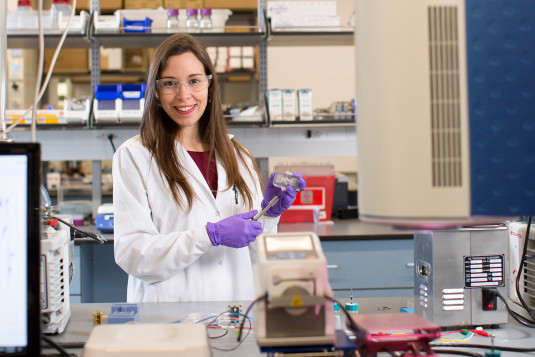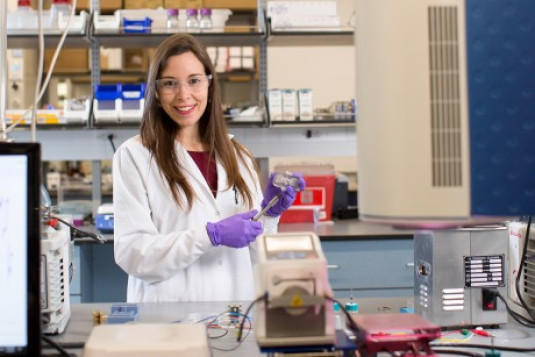
Tiny particles make a big impact
Since she was a child, Sangeeta Bhatia has enjoyed figuring out how things work. Now a biomedical researcher, MIT professor, and biotech entrepreneur, she has invented human microlivers to study drug metabolism and liver disease as well as nanoparticles that help diagnose, study, and treat ailments like cancer. She is also a mentor, helping her students understand the importance of protecting their own intellectual property.
14 min read
Each month, our Journeys of Innovation series tells the stories of inventors or entrepreneurs whose groundbreaking innovations have made a positive difference in the world. Hear it in their own words or read the transcript below.
Sangeeta Bhatia: One thing that I was very interested in when we first started working in nanomaterials was the idea that if you change the size of the material, it can go to a different place in your body.
Marie Ladino: This realization was key to Sangeeta Bhatia’s research. Trained as both a physician and engineer, and now an MIT professor and entrepreneur, she uses micro- and nanotechnologies, also known as “tiny technologies,” to develop inventions for the diagnosis and treatment of cancer and to improve therapies for liver disease. Bhatia has also received the prestigious Heinz Award for her groundbreaking innovations and advocacy of women in STEM fields.
I’m Marie Ladino from the United States Patent and Trademark Office. My colleague Linda Hosler recently spoke to Bhatia about how she adapted technologies developed in the computer industry for use in medical innovation. Here is a bit of their conversation.
Invention for me personally is almost like art. It’s a very creative process that’s not linear.
Linda Hosler: Could you tell me a little bit about your research and your inventions?
Sangeeta Bhatia: My research and inventions are based on the idea that micro- and nanotechnologies that have emerged from the world of semiconductor fabrication may be useful for impacting healthcare. So we use the tiny technologies to make medical inventions.
Linda Hosler: Could you describe some of those medical inventions?
Sangeeta Bhatia: Sure. So we’ve been interested in using techniques like microfabrication to pattern cells on surfaces in two dimensions and three dimensions and help them function better, both to understand human disease and also to improve transplantation. And then we’ve also been interested in making nanomaterials that are so small that they could enter into the body and deliver drugs locally to diseases and make measurements that would be otherwise unachievable.
Linda Hosler: One thing that I come across a lot when I talk to inventors is that invention is really coming from identifying a problem that needs to be solved. What was the specific problem you wanted to solve, and how did you go about solving it?
Sangeeta Bhatia: I think invention for me personally is almost like art. It’s a very creative process that’s not linear. So it’s, it’s, it’s pretty rare that one of our inventions ends up finding its sort of killer application in the way that we envisioned in the beginning.
But just as an example, I was interested as a graduate student with Mehmet Toner at the Mass General Hospital in making an artificial liver device. And this device would be like a kidney dialysis cartridge. And the idea was that you would put living cells in the device, and they would process blood for patients with liver failure. And one of the challenges in the field had been that the liver cells, when put in contact with plastic, would stop behaving like liver cells. And so most of my Ph.D. was just trying to understand how to make them happier. And we did that with these micropatterning methods. So we would pattern surfaces and cluster them together and then add another cell type as a neighbor, and called these micropatterned co-cultures. And the goal of all of this work was to make them happier, and then to be able to put them in a cartridge and run patients’ blood through it. And, you know, somewhere, I think mid-Ph.D., my advisor and I both realized that the project that we, as we envisioned it was, like, never going to happen. It was way too hard, but we had invented a way to keep liver cells happy on a surface.
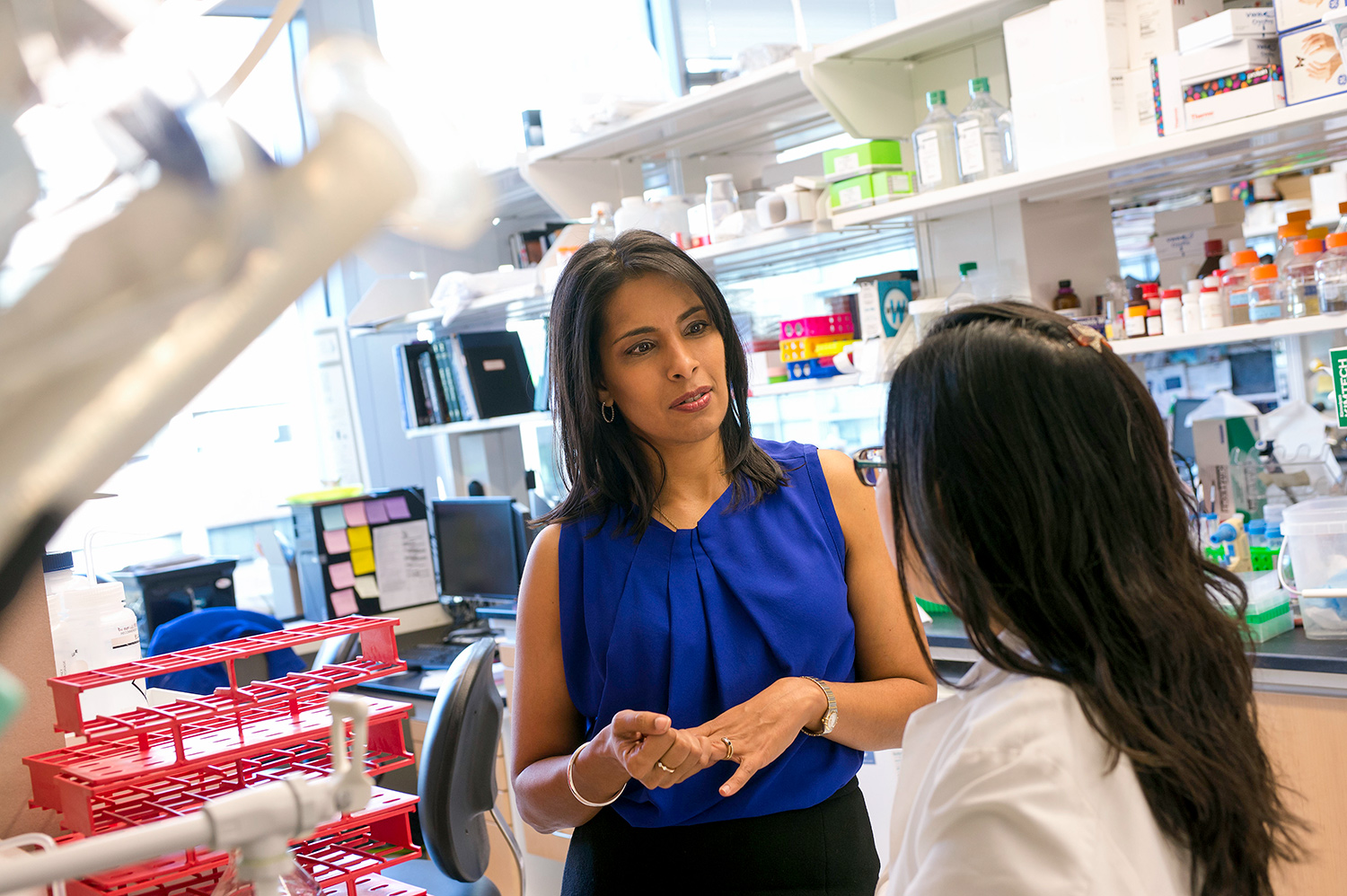
Sangeeta Bhatia discusses research with a student in her MIT lab, the Laboratory for Multiscale Regenerative Technologies. Image courtesy of Len Rubenstein.
Sangeeta Bhatia: And so when I started my lab, I started realizing that if you could do that with human cells—human liver cells—instead of what we had been working on at the time, which were rat liver cells, then you could have a little human liver in a dish. And that would be incredibly useful for drug discovery and development, because many drugs are toxic in the liver, and they’re also metabolized in the liver. And so what I set out to do is then make these little human microlivers using the exact same methods, but now using human cells. And so we did that, and we commercialized that product. But it’s just an example of how, you know, we were trying to make a cartridge with happy liver cells, and we ended up making little human patient livers in a dish for drug testing. But both I think, you know, had an impact. But, but that sort of pivot is something that you hear a lot, I think, from inventors. We were trying to do one thing and actually found a solution to something else.
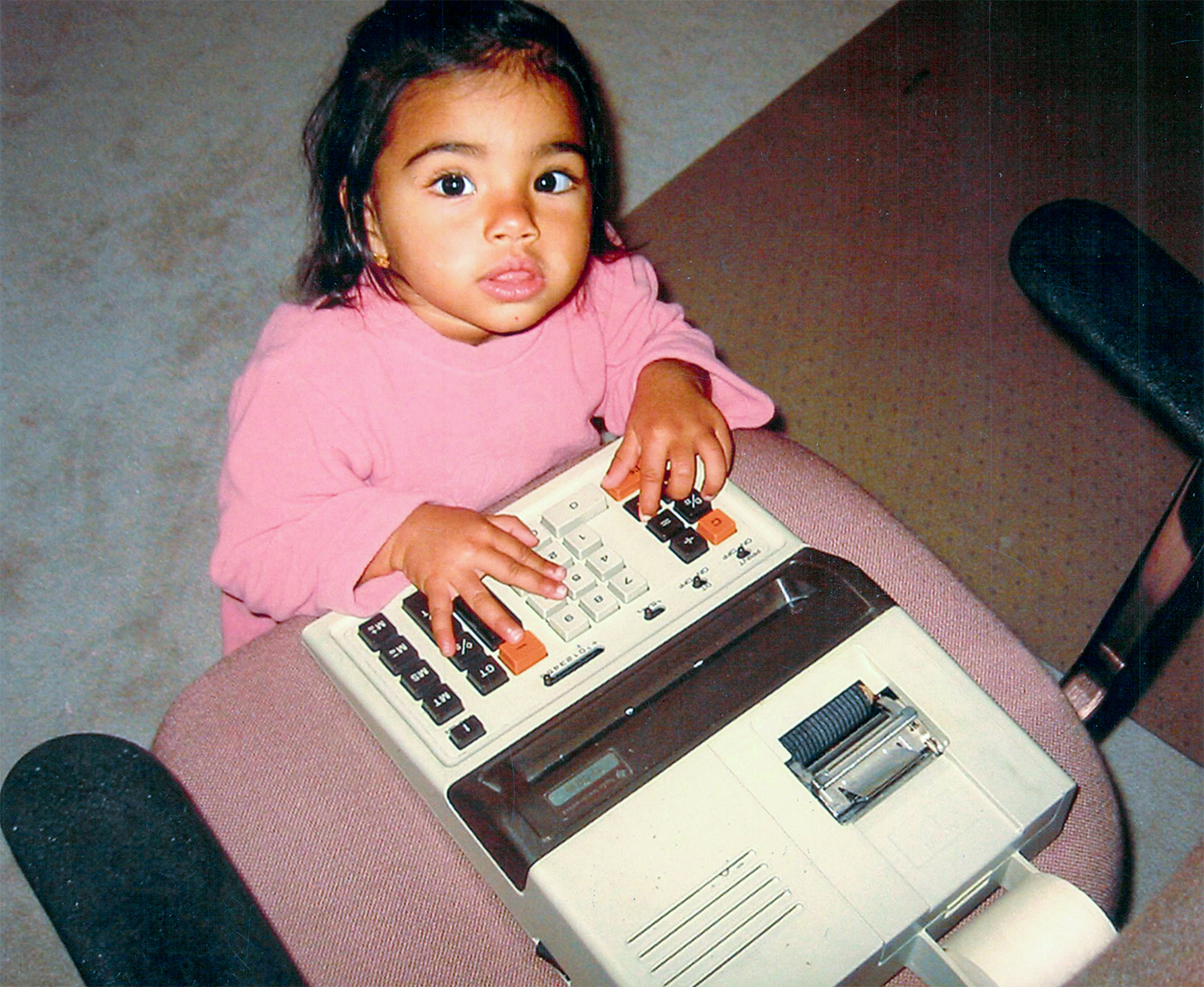
As a child, Sangeeta Bhatia liked to explore and create with her hands. This calculator captured her interest when she was about 2 years old. Image courtesy of Sangeeta Bhatia.
Linda Hosler: How did you first get interested in invention?
Sangeeta Bhatia: You know, I think I didn’t, I didn’t actually think of myself as an inventor for a long time, which is funny because now I’m a mom, and my, my youngest daughter is really inventive, and I say to her all the time, “Oh, you’re a little inventor.” But no one ever said that to me. Like, no one ever used that word. I was good at math and science, and I liked to tinker. And I was really creative with my hands. I would craft a lot. But I never really thought of myself as an inventor.
But as a graduate student, when we had this finding about preserving cells in culture, the night of my Ph.D. defense, my advisor said to me, “Oh my gosh, I think we’d better file this before midnight, you know, in case this is somehow enabling.” And so I actually called from the restaurant, my celebration dinner—you know, in the old days, so there was no cell phones—like, on the phone on the wall, on the pay phone. I was talking to the patent attorneys filing the first patent, my first patent, which then became actually the foundational patent for this startup that commercialized the work, you know, eight years later. So that was how I became an inventor, but sort of accidentally, having invented it and not realizing it was an invention.
Linda Hosler: To jump on that a little bit, could you talk about why it was important for you to receive a patent and why you, you know, stopped in the middle of your celebrations to go talk to an attorney?
Sangeeta Bhatia: Yeah, I really, at the time I think we had no conception that this would necessarily be valuable. But he, he had, you know, he had trained at MIT. And I think we have sort of that muscle memory here of knowing that you should protect things if you want to protect their possibility of future investments, even in the moment not knowing what that might look like. And that was kind of what was behind his urging that we should do it. And, and what it meant later was that when we did actually make the livers out of human cells and show that they could predict drug safety and that they could be useful for drug metabolism, and then later that they could be used for hepatitis C and hepatitis B and malaria and CRISPR and gene therapy—when we went on to show that, and it became clear that there was going to be value in sharing this with the community, the path forward was that we needed to do a startup to develop the technology and take it to the next level. And we needed to raise venture investment. And unless we could show that we had protection, that we had intellectual property, there was no way to, to raise the, that investment. So it was actually crucial that we had that issued patent by the time we wanted to take the technology to the next level.
Give yourself permission to invent and be creative and find the ... areas where there’s real blue sky.
Linda Hosler: So you talked about, you know, having Eureka moments and that kind of thing. What about a specific time that you felt like you failed or that you wanted to quit?
Sangeeta Bhatia: Hmmm. Well, there are things that we’ve tried to do that have never quite worked out in a way I imagine them. And it ended up that we made a different observation and we went in a different direction, and they actually became inventions. So I’ll give you an example. So one thing that I was very interested in when we first started working in nanomaterials was the idea that if you change the size of the material, it can go to a different place in your body.
So, like, it was so interesting to me that you can take a piece of gold, and if it was two nanometers, it would go into the urine, and if it was 20 nanometers, it would go into the liver. So I was really interested in this idea that things could be concentrated in the urine for a long time. And we were trying to do that with, with nanomaterials—with gold—and then we could never get it working. And one day, we were trying to do something completely different, which was to make an MRI contrast agent for tumors. And we started noticing the bladder lighting up every time we gave this material. And only because in the past I had been interested in urine concentration was I able to sort of say, like, “Oh, that’s actually the thing that we wanted to get working 10 years ago that never worked.” And it turned out what had happened was that we were giving a material and that enzymes were acting on it and liberating a tiny little fragment, which was no longer a nanomaterial but just a molecule, and the molecule was coming out in the urine. And we had invented this class of sensors that we call “activity-based sensors.” So it, you know, it was a failure at the time, but it sort of sat there in the back of my head as something that I’ve been always kind of interested in, and it kind of orients you in the direction of recognizing success when it arrives.
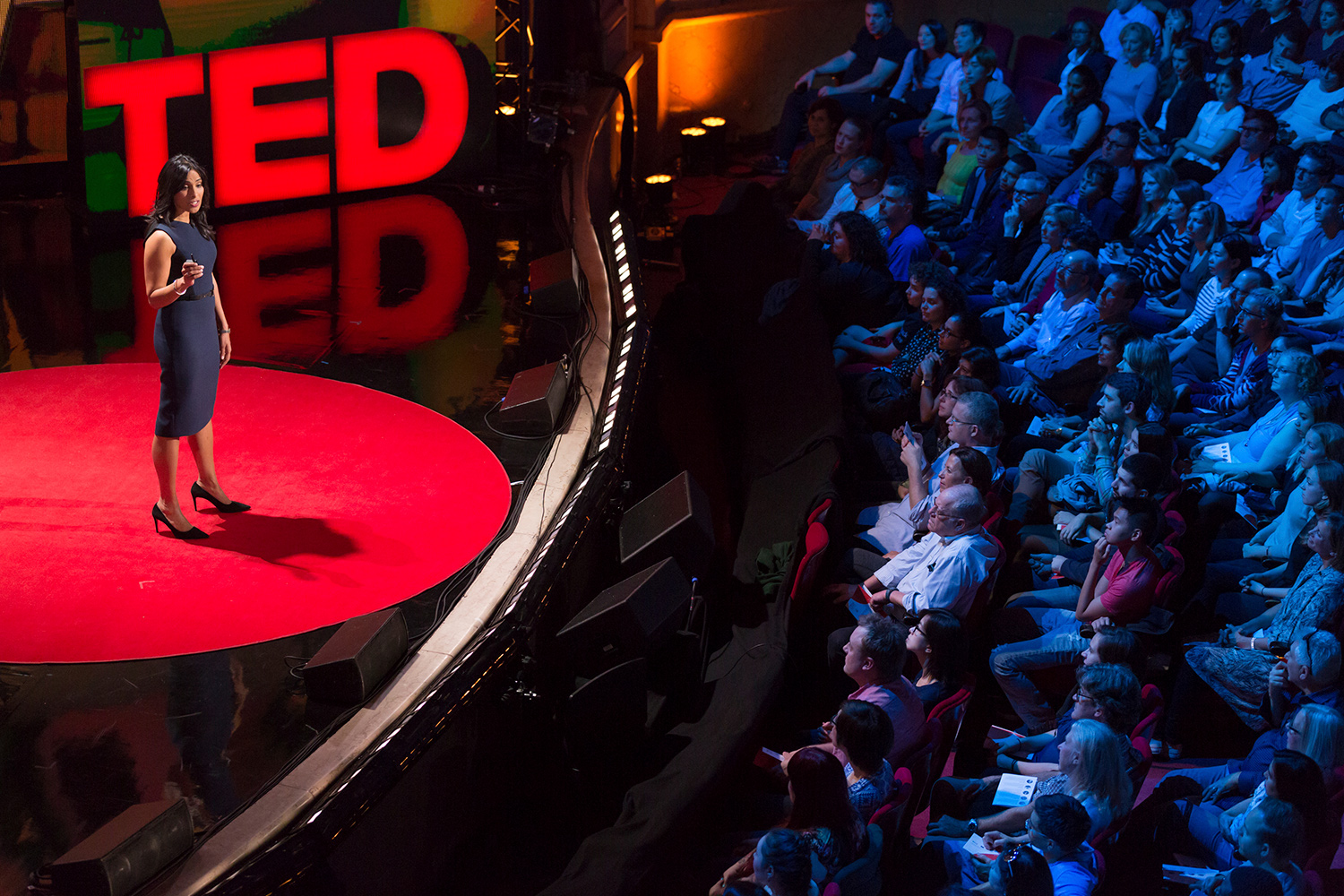
In November 2015, Sangeeta Bhatia gave a TED Talk titled “This tiny particle could roam your body to find tumors,“ explaining her recent research to a packed auditorium. Image courtesy of Ryan Lash.
Linda Hosler: You’ve talked about startups. Do you think of yourself as an entrepreneur?
Sangeeta Bhatia: I do. I mean, I think, I think about myself as somebody who has a lot of different facets, and entrepreneurship is one of them that I think has been necessary to advance our inventions to patients, which is, you know—ultimately, what I’m interested in is impact.
Linda Hosler: But how do you marry the inventor side and the, and the entrepreneurship side?
Sangeeta Bhatia: I’m really fortunate that MIT is such a sort of well-oiled machine in this regard. You know, we think we have been trained very well by our TLO [Technology Licensing Office] in terms of how to protect things. And they, they fortunately, actually, you know, have the budget to protect things really at risk. So they believe in us as inventors, and they know that they can invest in a project, sometimes for years or a series of patents. And, you know, I think because the timescales in bio are particularly long, it is really important to sort of, to be patient and to recognize that the value of the invention may actually be 10 years in the future.
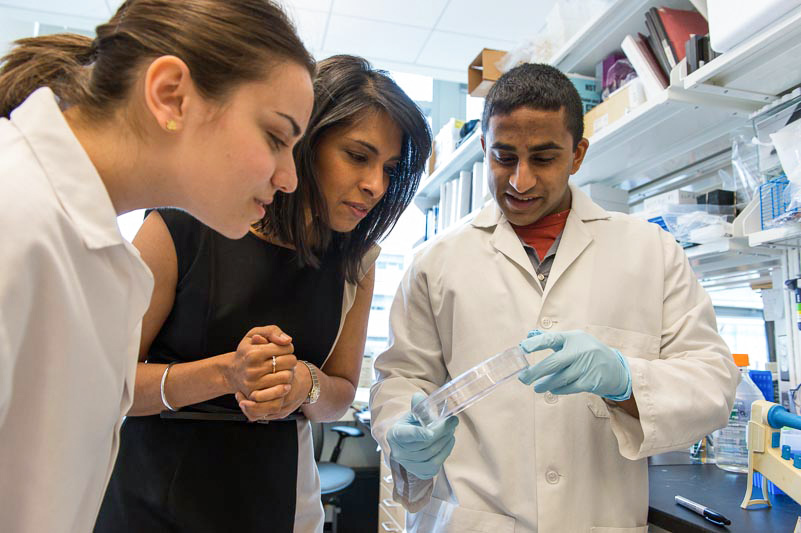
Sangeeta Bhatia and her students have explored the use of CRISPR-Cas9, a genome editing tool, for the treatment of hepatitis B. Image courtesy of Justin Knight.
Linda Hosler: You talked about, you know, your, your Ph.D. advisor and, and others who have, you’ve worked with. What has the role of mentorship been, either your mentors or mentoring others?
Sangeeta Bhatia: I think you really have to enable people explicitly. On Fridays—which I call “Science Friday”—is our Science Friday. We only do science. We have little affinity groups. And so, right now I, for example, I have the cancer subgroup and the liver subgroup and an infection subgroup. And the students get together with me, and we show unpublished data, and we talk about, you know, what’s working, what’s not working. And a lot of the times, I will recognize, you know, a step change, like a key result. And I’ll say to the students in front of all the rest of them, “You should, you know, do a patent search, see what’s in this space, see if this is really new, and if so, we should file a disclosure.” And then when it comes time to file a disclosure, I will talk about in front of everybody, you know, sort of my rubrics for filing a disclosure and how they’re different from writing a paper and how you need to really articulate clearly what the inventive step was. And so, you know, I think they sort of learn it by, by, by watching over and over again. And then in their own work, they can see like, oh, this is sort of like what happened to so-and-so two months ago.

Sangeeta Bhatia sees her daughter Anjali, pictured at age 3 in 2006, as a burgeoning inventor and engineer. Image courtesy of Sangeeta Bhatia.
Linda Hosler: How about you growing up—was it a parent or a teacher or someone who really made you interested in science in the first place?
Sangeeta Bhatia: Yeah, I had two mentors. So my dad was an engineer and then a serial entrepreneur. And so he, when he saw that I was good in math and science and I really liked my biology class, he said to me, kind of senior year in high school, “I think you should learn about bioengineering.” I mean this was the ’80s, so it was, it was really early days, and I, I didn’t know what engineering was, nevermind bioengineering. He actually brought me to MIT to a friend of the family’s lab, and they were doing focused ultrasound for hyperthermic cancer treatment. And it really captured my imagination, you know, the idea that you could make instruments that could impact human health.
I was also always creating, like, physically, with my hands. So nowadays kids would be like in robotics camp, but I was doing things like stained glass and latch hook and string art. My mom always says, “You were always just like, you know, creating with your hands and your mind and, you know, doing well in your math classes.” And we don’t think of engineers that way, mostly because we have like a male conception of engineering. But now I can see in my daughter, you know, that she’s a budding little engineer. She has all those attributes.
Linda Hosler: And that’s actually a perfect segue. I wanted to close up by asking you what advice would you give to other innovators?
Sangeeta Bhatia: Hmmm. I think just to sort of really give yourself permission to invent and be creative and find the, find the areas where there’s real blue sky. I think, I think there’s a lot of, of pressure to, you know, go where the funding is, and work on, work in a certain area that’s hot. And, and actually, I think for me what’s been most fruitful in my career and ultimately the most rewarding is to, to go into a space where there isn’t actually anything and invent. You know, it’s such an opportunity to make such a big impact. Since I’m medically trained, you know, I always look to the clinic. You know, I always say like, okay, well, it seems very scary now, but like, let me, let me actually remember that liver disease is an area where there is still no good treatments other than transplants. Of course there’s room for invention. And, and just constantly, you know, remind yourself and give yourself permission to be creative.
Linda Hosler: Looking back at the impacts of your inventions and your research, what are you most proud of?
Sangeeta Bhatia: So I’m actually most proud of the people that I’ve trained. I think, I very deliberately—and we have a culture here of, of excellence and collaboration, which is really important, but also kindness and good citizenship. And, you know, I’ve trained a whole bunch of people now that have gone on to, to repeat that model in their own place. And, you know, so they’re sort of replicating, you know, our approach and our culture, you know, kind of all over the world. It’s just, just to be a multiplier like that is really gratifying.
Marie Ladino: Many thanks to Sangeeta Bhatia for taking the time to discuss her efforts to improve human health. Although the particles she studies are minute, the impact of her work has been monumental. From the USPTO, thanks for listening.
Credits
Produced by the USPTO Office of the Chief Communications Officer. For feedback or questions, please contact inventorstories@uspto.gov.
Interview by Linda Hosler. Audio editing by Jay Premack. Story production by Marie Ladino. Additional contributions from Lauren Emanuel and Jeff Isaacs. Photo on the USPTO homepage courtesy of Scott Eisen/AP Images for the Howard Hughes Medical Institute. Photo at the top of this page courtesy of Len Rubenstein. All other photos credited in the captions.


